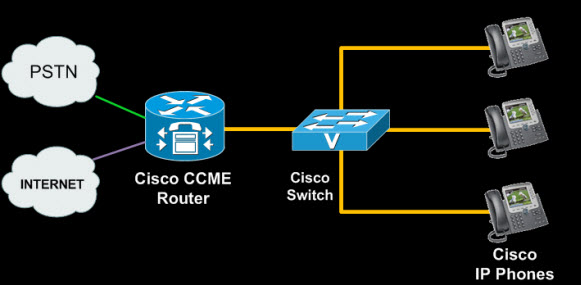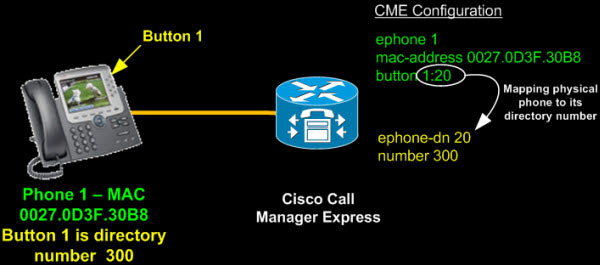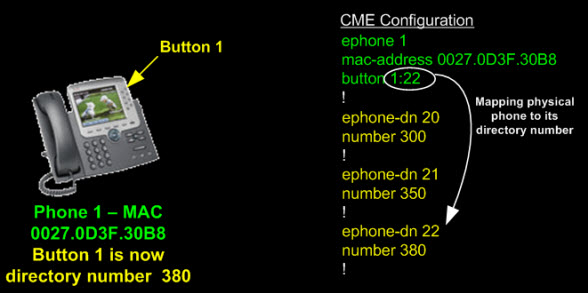Cisco CallManager Express Basic Concepts - Part 2
Our previous article, Cisco CallManager Express Basic Concepts - Part 1 covered the very basic concepts of CCME and its operation. This article continues with the Cisco CallManager Express basic concepts will examine and analyse the ephone, ephone-dn concepts, how to configure ip phones and voip-bandwidth considerations.
Understanding Ephone & Ephone-dn
The Cisco CallManager Express system consists of a router (or simply a 'box' for the UC 500 series) that serves as a voice gateway (PBX) and one or more VLANs that connect IP phones and phone devices to the router.

All type of PBXs consist of physical phones and their internal directory numbers (extensions). The same concept applies in CallManager Express. The physical phones are referred to as 'ephone' which stands for 'Ethernet Phone' and the directory numbers as 'ephone-dn' short for 'Ethernet Phone Directory Number':

An ephone can represent any type/model of physical phone available and supported by Cisco. CallManager Express will recognise a physical phone device from its ephone configuration which also contains the device's MAC address.
For example, a Cisco 7945 IP Phone with a MAC address of 0027.0D3F.30B8 represents the ephone. Directory number 32 assigned to this phone represents the ephone-dn number.
Directory numbers are assigned to line buttons on phones during configuration.
This means that each physical IP Phone must be configured as an ephone. Cisco CallManager Express will recognise the physical phone from its ephone configuration MAC Address parameter.

Configuring an IP Phone in CME is a straightforward process and involves the creation of an ephone and ephone-dn entry.
The ephone holds the phone's MAC Address and button configuation, while the ephone-dn the directory number assigned to the IP Phone.
In the example above, the ephone 1 configuration binds the phone's first button (button 1) to the ephone-dn 20. Since ephone-dn 20 has been configured with directory number 300, the IP Phone will be assigned directory number 300.
To ensure we understand this concept, consider the following example:

Using the same scenario we've created three ephone-dn entries, a total of three directory numbers. We would now like to assign Phone 1, directory number 380. All that is required is to map button 1 to the approriate ephone-dn that contains number 380, that is ephone-dn 22. To achieve this, we issue the button 1:22 command under the ephone 1 configuration. IP Phone 1 now has directory number 380!
VoIP Bandwidth - Codecs
VoIP calls, just as any other network resource, require bandwidth. The amount of bandwidth required per call is governed by the type of codec configured by the system. Cisco CME and UC500 series support a variety of different codecs, making the system extremely flexible to cover any requirement.
By default, the codec used by Call Manager Express and UC500 series, is G.711 which requires 64Kbps of bandwidth – the same amount of bandwidth used by telecommunication providers for one call. Note that 64Kbps is the data payload, this means when captured into an Ethernet packet, the total amount of bandwidth will be the data payload plus the IP packet overhead, bringing the total amount to 87.2 Kbps. This is the actual bandwidth required per call per phone on an Ethernet network.
The amount of 87.2 Kbps might not seem large for an Ethernet network, however, when we need to pass the call over a WAN network this changes completely. WAN networks require bandwidth-optimised applications and services and there is no exception for VoIP calls.
For this reason, when we are dealing with situations that require optimised bandwidth control, we switch to different codecs that have much smaller bandwidth requirements, essentially allowing us to conserve precious bandwidth and money. In these cases, the G.729 codec is usually preferred, requiring only 31.2 Kbps, a generous saving of 56Kbps! In practice, this means that you can squeeze almost three G.729 VoIP calls using the same amount of bandwidth required by one G.711 VoIP call!
Apart from the evident difference in bandwidth requirements for each codec, there is also a noticeable difference in the quality of the call, G.711 being far superior in comparison with the G.729. To help provide an example, the quality of a G.711 call is similar to that of a call made between two ISDN land lines whereas a good example of G.729 quality would be a call between two mobile phones.
Taking in consideration that the quality of mobile phone calls is acceptable to everyone today, not many would complain if they had the same quality between site-to-site calls.
Of course there are other codecs that require a different amount of bandwidth, however, the two most important and popular are the G.711 and G.729 codecs. These codecs can be further configured to change their bandwidth requirements, but that's a topic to be covered in the future.
Summary
This article covered the introduction to Cisco's Call Manager Express which runs on Cisco routers and UC 500 series appliances (including UC520, UC540 & UC560). Basic concepts of VoIP technologies were introduced along with some important configuration theory related to CME's operation. Users interested can also read our Cisco CallManager Express Basic Concepts - Part 1 article.
Wi-Fi Key Generator
Follow Firewall.cx
Cisco Password Crack
Decrypt Cisco Type-7 Passwords on the fly!














